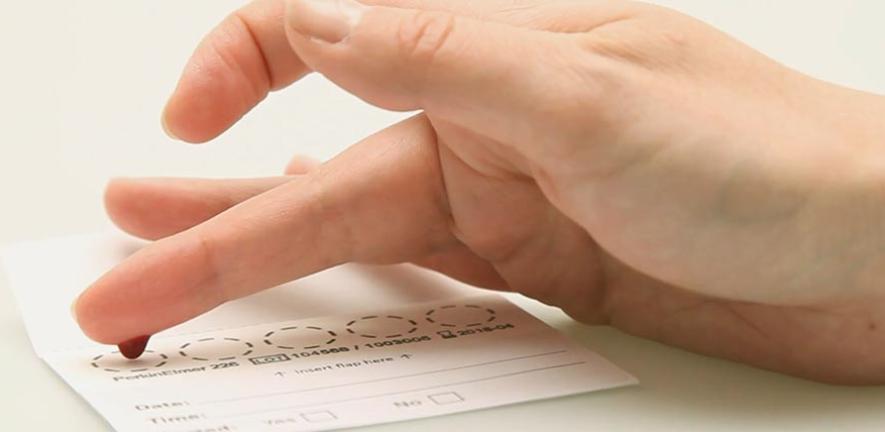
Researchers have developed a new way of improving diagnosis of bipolar disorder that uses a simple blood test to identify biomarkers associated with the condition.
Researchers have developed a new way of improving diagnosis of bipolar disorder that uses a simple blood test to identify biomarkers associated with the condition.
The ability to diagnose bipolar disorder with a simple blood test could ensure that patients get the right treatment the first time
Jakub Tomasik
The researchers, from the University of Cambridge, used a combination of an online psychiatric assessment and a blood test to diagnose patients with bipolar disorder, many of whom had been misdiagnosed with major depressive disorder.
The researchers say the blood test on its own could diagnose up to 30% of patients with bipolar disorder, but that it is even more effective when combined with a digital mental health assessment.
Incorporating biomarker testing could help physicians differentiate between major depressive disorder and bipolar disorder, which have overlapping symptoms but require different pharmacological treatments.
Although the blood test is still a proof of concept, the researchers say it could be an effective complement to existing psychiatric diagnosis and could help researchers understand the biological origins of mental health conditions. The results are reported in the journal JAMA Psychiatry.
Bipolar disorder affects approximately one percent of the population – as many as 80 million people worldwide – but for nearly 40% of patients, it is misdiagnosed as major depressive disorder.
“People with bipolar disorder will experience periods of low mood and periods of very high mood or mania,” said first author Dr Jakub Tomasik, from Cambridge’s Department of Chemical Engineering and Biotechnology. “But patients will often only see a doctor when they’re experiencing low mood, which is why bipolar disorder frequently gets misdiagnosed as major depressive disorder.”
“When someone with bipolar disorder is experiencing a period of low mood, to a physician, it can look very similar to someone with major depressive disorder,” said Professor Sabine Bahn, who led the research. “However, the two conditions need to be treated differently: if someone with bipolar disorder is prescribed antidepressants without the addition of a mood stabiliser, it can trigger a manic episode.”
The most effective way to get an accurate diagnosis of bipolar disorder is a full psychiatric assessment. However, patients often face long waits to get these assessments, and they take time to carry out.
“Psychiatric assessments are highly effective, but the ability to diagnose bipolar disorder with a simple blood test could ensure that patients get the right treatment the first time and alleviate some of the pressures on medical professionals,” said Tomasik.
The researchers used samples and data from the Delta study, conducted in the UK between 2018 and 2020, to identify bipolar disorder in patients who had received a diagnosis of major depressive disorder within the previous five years and had current depressive symptoms. Participants were recruited online through voluntary response sampling.
More than 3000 participants were recruited, and they each completed an online mental health assessment of more than 600 questions. The assessment covered a range of topics that may be relevant to mental health disorders, including past or current depressive episodes, generalised anxiety, symptoms of mania, family history or substance abuse.
Of the participants who completed the online assessment, around 1000 were selected to send in a dried blood sample from a simple finger prick, which the researchers analysed for more than 600 different metabolites using mass spectrometry. After completing the Composite International Diagnostic Interview, a fully structured and validated diagnostic tool to establish mood disorder diagnoses, 241 participants were included in the study.
Analysis of the data showed a significant biomarker signal for bipolar disorder, even after accounting for confounding factors such as medication. The identified biomarkers were correlated primarily with lifetime manic symptoms and were validated in a separate group of patients who received a new clinical diagnosis of major depressive disorder or bipolar disorder during the study’s one-year follow-up period.
The researchers found that the combination of patient-reported information and the biomarker test significantly improved diagnostic outcomes for people with bipolar disorder, especially in those where the diagnosis was not obvious.
“The online assessment was more effective overall, but the biomarker test performs well and is much faster,” said Bahn. “A combination of both approaches would be ideal, as they’re complementary.”
“We found that some patients preferred the biomarker test, because it was an objective result that they could see,” said Tomasik. “Mental illness has a biological basis, and it’s important for patients to know it’s not in their mind. It’s an illness that affects the body like any other.”
“In addition to the diagnostic capabilities of biomarkers, they could also be used to identify potential drug targets for mood disorders, which could lead to better treatments,” said Bahn. “It’s an exciting time to be in this area of research.”
A patent has been filed on the research by Cambridge Enterprise, the University’s commercialisation arm. The research was supported by the Stanley Medical Research Institute and Psyomics, a University spin-out company co-founded by Sabine Bahn.
Sabine Bahn is Professor of Neurotechnology at the Department of Chemical Engineering and Biotechnology and is a Fellow of Lucy Cavendish College, Cambridge.
Reference:
Jakub Tomasik et al. ‘Metabolomic Biomarker Signatures for Bipolar and Unipolar Depression.’ JAMA Psychiatry (2023). DOI: 10.1001/jamapsychiatry.2023.4096

The text in this work is licensed under a Creative Commons Attribution-NonCommercial-ShareAlike 4.0 International License. Images, including our videos, are Copyright ©University of Cambridge and licensors/contributors as identified. All rights reserved. We make our image and video content available in a number of ways – as here, on our main website under its Terms and conditions, and on a range of channels including social media that permit your use and sharing of our content under their respective Terms.




